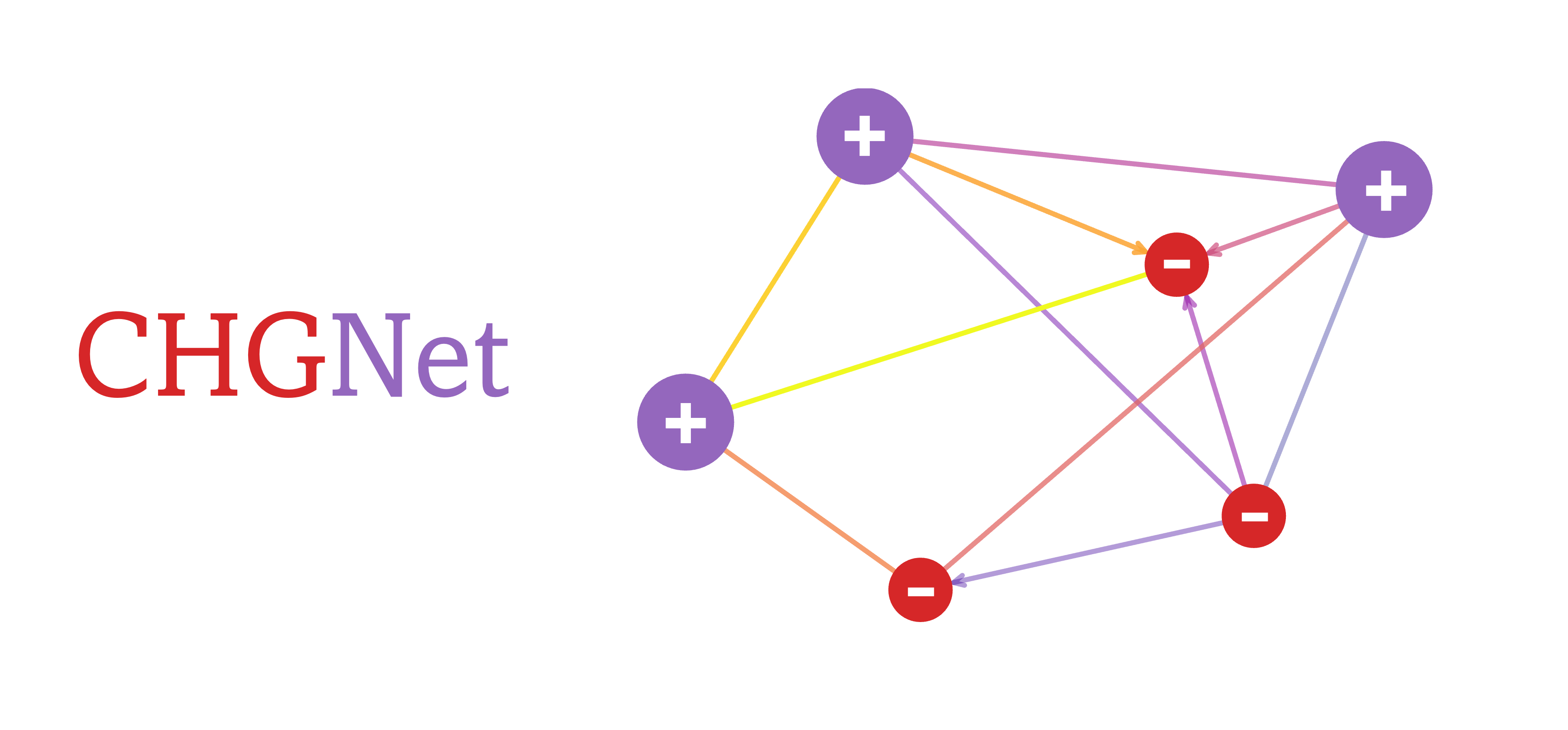
Product
Introducing Scala and Kotlin Support in Socket
Socket now supports Scala and Kotlin, bringing AI-powered threat detection to JVM projects with easy manifest generation and fast, accurate scans.
Pretrained Universal Neural Network Potential for Charge-informed Atomistic Modeling
A pretrained universal neural network potential for
charge-informed atomistic modeling (see publication)
 Crystal Hamiltonian Graph neural Network is pretrained on the GGA/GGA+U static and relaxation trajectories from Materials Project,
a comprehensive dataset consisting of more than 1.5 Million structures from 146k compounds spanning the whole periodic table.
Crystal Hamiltonian Graph neural Network is pretrained on the GGA/GGA+U static and relaxation trajectories from Materials Project,
a comprehensive dataset consisting of more than 1.5 Million structures from 146k compounds spanning the whole periodic table.
CHGNet highlights its ability to study electron interactions and charge distribution in atomistic modeling with near DFT accuracy. The charge inference is realized by regularizing the atom features with DFT magnetic moments, which carry rich information about both local ionic environments and charge distribution.
Pretrained CHGNet achieves excellent performance on materials stability prediction from unrelaxed structures according to Matbench Discovery [repo].
| Notebooks | Google Colab | Descriptions |
|---|---|---|
| CHGNet Basics | Examples for loading pre-trained CHGNet, predicting energy, force, stress, magmom as well as running structure optimization and MD. | |
| Tuning CHGNet | Examples of fine tuning the pretrained CHGNet to your system of interest. | |
| Visualize Relaxation | Crystal Toolkit app that visualizes convergence of atom positions, energies and forces of a structure during CHGNet relaxation. | |
| Phonon DOS + Bands | Use CHGNet with the atomate2 phonon workflow based on finite displacements as implemented in Phonopy to calculate phonon density of states and band structure for Si (mp-149). | |
| Elastic tensor + bulk/shear modulus | Use CHGNet with the atomate2 elastic workflow based on a stress-strain approach to calculate elastic tensor and derived bulk and shear modulus for Si (mp-149). |
pip install chgnet
if PyPI installation fails or you need the latest main branch commits, you can install from source:
pip install git+https://github.com/CederGroupHub/chgnet
See the sciML webinar tutorial on 2023-11-02 and API docs.
Pretrained CHGNet can predict the energy (eV/atom), force (eV/A), stress (GPa) and
magmom ($\mu_B$) of a given structure.
from chgnet.model.model import CHGNet
from pymatgen.core import Structure
chgnet = CHGNet.load()
structure = Structure.from_file('examples/mp-18767-LiMnO2.cif')
prediction = chgnet.predict_structure(structure)
for key, unit in [
("energy", "eV/atom"),
("forces", "eV/A"),
("stress", "GPa"),
("magmom", "mu_B"),
]:
print(f"CHGNet-predicted {key} ({unit}):\n{prediction[key[0]]}\n")
Charge-informed molecular dynamics can be simulated with pretrained CHGNet through ASE python interface (see below),
or through LAMMPS.
from chgnet.model.model import CHGNet
from chgnet.model.dynamics import MolecularDynamics
from pymatgen.core import Structure
import warnings
warnings.filterwarnings("ignore", module="pymatgen")
warnings.filterwarnings("ignore", module="ase")
structure = Structure.from_file("examples/mp-18767-LiMnO2.cif")
chgnet = CHGNet.load()
md = MolecularDynamics(
atoms=structure,
model=chgnet,
ensemble="nvt",
temperature=1000, # in K
timestep=2, # in femto-seconds
trajectory="md_out.traj",
logfile="md_out.log",
loginterval=100,
)
md.run(50) # run a 0.1 ps MD simulation
The MD defaults to CUDA if available, to manually set device to cpu or mps:
MolecularDynamics(use_device='cpu').
MD outputs are saved to the ASE trajectory file, to visualize the MD trajectory and magnetic moments after the MD run:
from ase.io.trajectory import Trajectory
from pymatgen.io.ase import AseAtomsAdaptor
from chgnet.utils import solve_charge_by_mag
traj = Trajectory("md_out.traj")
mag = traj[-1].get_magnetic_moments()
# get the non-charge-decorated structure
structure = AseAtomsAdaptor.get_structure(traj[-1])
print(structure)
# get the charge-decorated structure
struct_with_chg = solve_charge_by_mag(structure)
print(struct_with_chg)
To manipulate the MD trajectory, convert to other data formats, calculate mean square displacement, etc, please refer to ASE trajectory documentation.
CHGNet can perform fast structure optimization and provide site-wise magnetic moments. This makes it ideal for pre-relaxation and
MAGMOM initialization in spin-polarized DFT.
from chgnet.model import StructOptimizer
relaxer = StructOptimizer()
result = relaxer.relax(structure)
print("CHGNet relaxed structure", result["final_structure"])
print("relaxed total energy in eV:", result['trajectory'].energies[-1])
CHGNet 0.3.0 is released with new pretrained weights! (release date: 10/22/23)
CHGNet.load() now loads 0.3.0 by default,
previous 0.2.0 version can be loaded with CHGNet.load('0.2.0')
Fine-tuning will help achieve better accuracy if a high-precision study is desired. To train/tune a CHGNet, you need to define your data in a
pytorch Dataset object. The example datasets are provided in data/dataset.py
from chgnet.data.dataset import StructureData, get_train_val_test_loader
from chgnet.trainer import Trainer
dataset = StructureData(
structures=list_of_structures,
energies=list_of_energies,
forces=list_of_forces,
stresses=list_of_stresses,
magmoms=list_of_magmoms,
)
train_loader, val_loader, test_loader = get_train_val_test_loader(
dataset, batch_size=32, train_ratio=0.9, val_ratio=0.05
)
trainer = Trainer(
model=chgnet,
targets="efsm",
optimizer="Adam",
criterion="MSE",
learning_rate=1e-2,
epochs=50,
use_device="cuda",
)
trainer.train(train_loader, val_loader, test_loader)
Check fine-tuning example notebook
CHGNet.CHGNet comes from GGA+U DFT with MaterialsProject2020Compatibility corrections applied.
The parameter for VASP is described in MPRelaxSet.
If you're fine-tuning with MPRelaxSet, it is recommended to apply the MP2020
compatibility to your energy labels so that they're consistent with the pretrained dataset.AtomRef.CHGNet stress is in units of GPa, and the unit conversion has already been included in
dataset.py. So VASP stress can be directly fed to StructureDataGraphData defined in
dataset.py, which reads graphs directly from saved directory. To create saved graphs,
see examples/make_graphs.py.The Materials Project trajectory (MPtrj) dataset used to pretrain CHGNet is available at figshare.
The MPtrj dataset consists of all the GGA/GGA+U DFT calculations from the September 2022 Materials Project. By using the MPtrj dataset, users agree to abide the Materials Project terms of use.
If you use CHGNet or MPtrj dataset, please cite this paper:
@article{deng_2023_chgnet,
title={CHGNet as a pretrained universal neural network potential for charge-informed atomistic modelling},
DOI={10.1038/s42256-023-00716-3},
journal={Nature Machine Intelligence},
author={Deng, Bowen and Zhong, Peichen and Jun, KyuJung and Riebesell, Janosh and Han, Kevin and Bartel, Christopher J. and Ceder, Gerbrand},
year={2023},
pages={1–11}
}
CHGNet is under active development, if you encounter any bugs in installation and usage,
please open an issue. We appreciate your contributions!
FAQs
Pretrained Universal Neural Network Potential for Charge-informed Atomistic Modeling
We found that chgnet demonstrated a healthy version release cadence and project activity because the last version was released less than a year ago. It has 1 open source maintainer collaborating on the project.
Did you know?

Socket for GitHub automatically highlights issues in each pull request and monitors the health of all your open source dependencies. Discover the contents of your packages and block harmful activity before you install or update your dependencies.

Product
Socket now supports Scala and Kotlin, bringing AI-powered threat detection to JVM projects with easy manifest generation and fast, accurate scans.

Application Security
/Security News
Socket CEO Feross Aboukhadijeh and a16z partner Joel de la Garza discuss vibe coding, AI-driven software development, and how the rise of LLMs, despite their risks, still points toward a more secure and innovative future.

Research
/Security News
Threat actors hijacked Toptal’s GitHub org, publishing npm packages with malicious payloads that steal tokens and attempt to wipe victim systems.